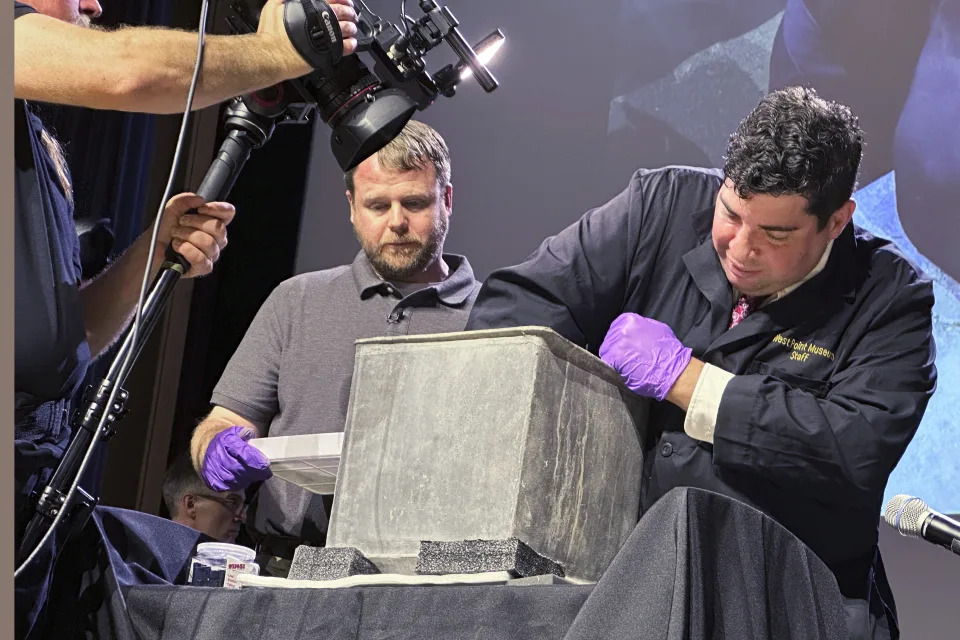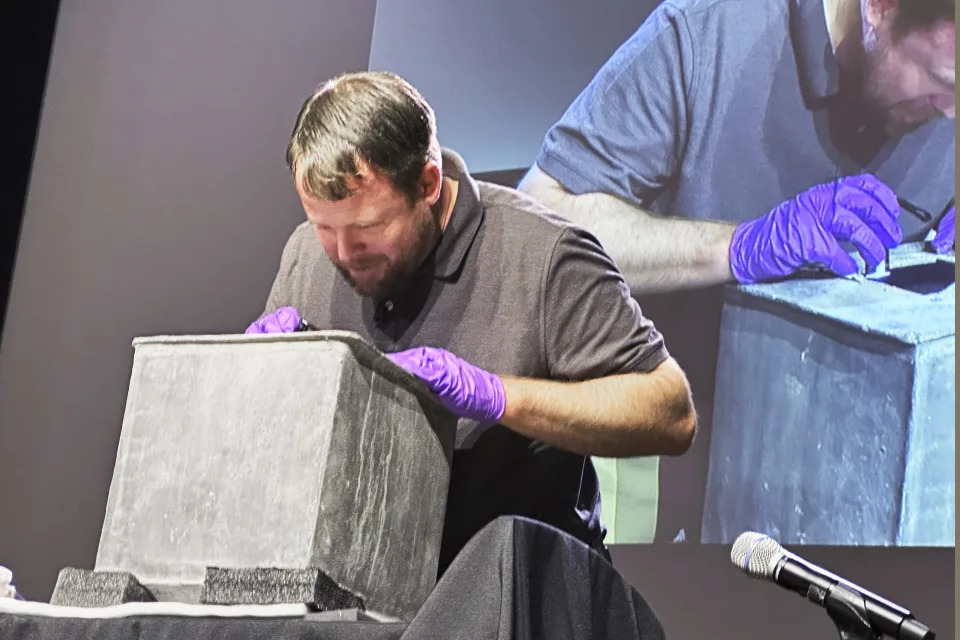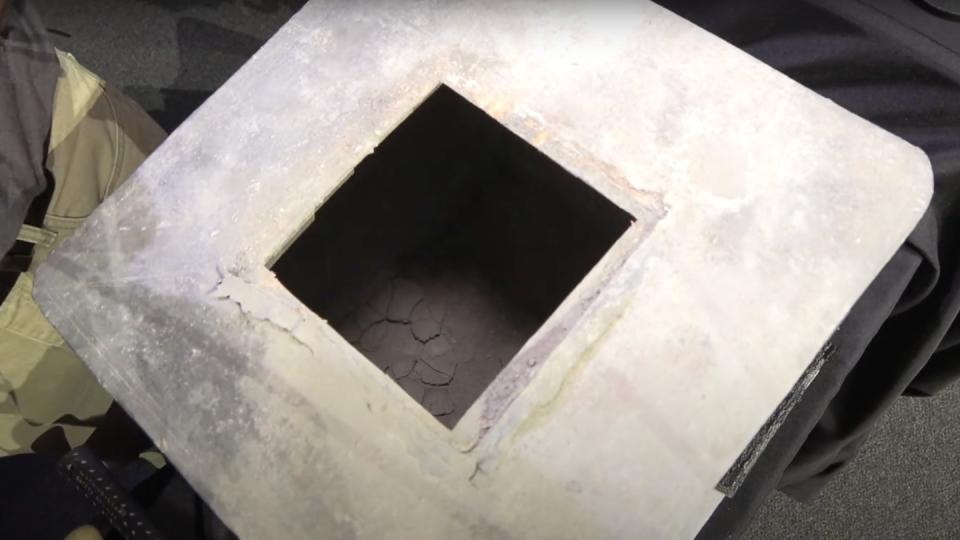After lots of hype, West Point treasure box opening yields no bombshells, just silt
MICHAEL HILL
Updated Mon, August 28, 2023


Paul Hudson, left, West Point archeologist, and Michael Diaz, West Point Museum curator, take part in the opening of a lead box believed to have been placed in the base of a monument by cadets almost two centuries ago, at the U.S. Military Academy, Monday, Aug. 28, 2023, in West Point, N.Y. The box contained silt. (AP Photo/Michael Hill)
WEST POINT, N.Y. (AP) — Excitement and anticipation dissolved into disappointment at West Point when a lead box believed to have been placed by cadets in the base of a monument almost two centuries ago was opened Monday during a livestreamed event and revealed to contain little more than gray dust.
An audience at the U.S. Military Academy hoped to see military relics or historical documents pulled from the box. Instead, they let out a groan after experts pried open the top and pointed a camera inside to show just a layer of sediment on the bottom.
West Point archeologist Paul Hudson and West Point Museum curator Michael Diaz gingerly lifted out a few gray clumps and dusted them with a brush, only to have them crumble into powder.
“A little disappointed. We built up to this quite a bit,” Hudson said after the event. “And I’ll tell you the truth, that was the last outcome that I expected with all the trouble that they went to create that box, put it in the monument."
The box, which is about a cubic foot, was discovered in May during the restoration of a monument honoring Revolutionary War hero Thaddeus Kosciuszko. That led to speculation there might be items inside honoring Kosciuszko or from cadet life in the late 1820s, when the monument was erected. Would there be any musket balls, messages from students, or clues to historical mysteries?
The underwhelming results of the live opening brought comparisons to Geraldo Rivera’s televised 1986 unsealing of a Chicago hotel vault purportedly belonging to gangster Al Capone, which infamously revealed nothing but dirt. In fact, academy officials joked about the possibility before the official unsealing.
“I was told yesterday that if we had a sense of humor, we would have asked Mr. Rivera to be up here with us,” Brig. Gen. Shane Reeves, the academy’s academic dean, told the crowd of cadets, officers and civilians.
Though they can't say for sure, Academy officials think the box was left by cadets in 1828 or 1829, when the original monument was completed. A committee of five cadets that included 1829 graduate Robert E. Lee, the future Confederate general, was involved with the dedication of the monument.
Kosciuszko had designed wartime fortifications for the Continental Army at West Point. He died in 1817. A statue of Kosciuszko was added to the monument in 1913.
Hudson said it appeared that moisture seeped in from a damaged seam on the box and it was likely that sediment got inside. The conditions also could have disintegrated any organic matter inside, like paper or wood.
“We’re going to remove all of that sediment and we’ll screen it through some fine mesh screen and see if anything comes out of it,” Hudson said.
Though historians aren’t certain of exactly when the box was placed in the monument, or who put it there, they say a stamp found Monday on the underside of the lid reading “E.W. Bank N.Y.” might provide a clue.
MICHAEL HILL
Updated Mon, August 28, 2023


Paul Hudson, left, West Point archeologist, and Michael Diaz, West Point Museum curator, take part in the opening of a lead box believed to have been placed in the base of a monument by cadets almost two centuries ago, at the U.S. Military Academy, Monday, Aug. 28, 2023, in West Point, N.Y. The box contained silt. (AP Photo/Michael Hill)
WEST POINT, N.Y. (AP) — Excitement and anticipation dissolved into disappointment at West Point when a lead box believed to have been placed by cadets in the base of a monument almost two centuries ago was opened Monday during a livestreamed event and revealed to contain little more than gray dust.
An audience at the U.S. Military Academy hoped to see military relics or historical documents pulled from the box. Instead, they let out a groan after experts pried open the top and pointed a camera inside to show just a layer of sediment on the bottom.
West Point archeologist Paul Hudson and West Point Museum curator Michael Diaz gingerly lifted out a few gray clumps and dusted them with a brush, only to have them crumble into powder.
“A little disappointed. We built up to this quite a bit,” Hudson said after the event. “And I’ll tell you the truth, that was the last outcome that I expected with all the trouble that they went to create that box, put it in the monument."
The box, which is about a cubic foot, was discovered in May during the restoration of a monument honoring Revolutionary War hero Thaddeus Kosciuszko. That led to speculation there might be items inside honoring Kosciuszko or from cadet life in the late 1820s, when the monument was erected. Would there be any musket balls, messages from students, or clues to historical mysteries?
The underwhelming results of the live opening brought comparisons to Geraldo Rivera’s televised 1986 unsealing of a Chicago hotel vault purportedly belonging to gangster Al Capone, which infamously revealed nothing but dirt. In fact, academy officials joked about the possibility before the official unsealing.
“I was told yesterday that if we had a sense of humor, we would have asked Mr. Rivera to be up here with us,” Brig. Gen. Shane Reeves, the academy’s academic dean, told the crowd of cadets, officers and civilians.
Though they can't say for sure, Academy officials think the box was left by cadets in 1828 or 1829, when the original monument was completed. A committee of five cadets that included 1829 graduate Robert E. Lee, the future Confederate general, was involved with the dedication of the monument.
Kosciuszko had designed wartime fortifications for the Continental Army at West Point. He died in 1817. A statue of Kosciuszko was added to the monument in 1913.
Hudson said it appeared that moisture seeped in from a damaged seam on the box and it was likely that sediment got inside. The conditions also could have disintegrated any organic matter inside, like paper or wood.
“We’re going to remove all of that sediment and we’ll screen it through some fine mesh screen and see if anything comes out of it,” Hudson said.
Though historians aren’t certain of exactly when the box was placed in the monument, or who put it there, they say a stamp found Monday on the underside of the lid reading “E.W. Bank N.Y.” might provide a clue.
Jon Simkins
Mon, August 28, 2023
The tension Monday in West Point’s Robinson Auditorium could be cut with a knife. A nearly 200-year-old lead time capsule sat center stage in a room brimming with anxious onlookers, its sealed lid slowly prying open as an archaeologist meticulously slid a gleaming blade from one side to the other.
A symphony of whispers and nervous laughter reached a crescendo as the surgeon’s tool approached its final cut. Inside the box’s mysterious one square foot of space could be anything — personal tokens of Thaddeus Kosciuszko, under whose monument the capsule was found, antiquated medals or coins, human remains, even a Christmastime leg lamp to proudly display in one’s bay window.
With one last incision, the lid wiggled free. The archaeologist reached for a flashlight, the cube’s dark interior preserving its final moments of secrecy. Top officers, senior historians, libraries, archivists and museum curators leaned forward, the oxygen in the room suddenly in short supply.
“Silt,” the archaeologist said. Just silt.

The dusty contents of West Point's mystery box. (West Point)
In what could either be the most dazzling illustration of an anticlimactic “hurry up and wait” gathering or one of the best pranks in military history — perhaps both — the culmination of a centuries-old mystery at the U.S. Military Academy amounted to little more than some dirt.
“The box didn’t quite meet expectations,” the container’s glove- and mask-clad handler said, sheepishly, as the auditorium’s tension swiftly relented to profound awkwardness. “Potentially, it was something small and organic that may have come apart over time, but we’re just not certain.”
The cube, which in recent months became the subject of numerous announcements, an unsealing save-the-date video and a YouTube livestream, was discovered during renovations earlier this year in the base of the campus’ Thaddeus Kosciuszko monument. The shrine stands as an homage to the Polish general and engineer who helped strengthen American defenses during the American Revolutionary War.
X-rays of the box conducted by the institution’s Department of Physics and Nuclear Engineering after its discovery were inconclusive, the academy said, adding to the intrigue of Monday’s sediment-rich unveiling. The lead object is believed to have been placed there in 1828, just 26 years after the academy was founded.
“This time capsule is truly a unique discovery, and we are excited to open it and see what the cadets left us nearly two centuries ago,” U.S. Military Academy Superintendent Lt. Gen. Steve Gilland said ahead of Monday’s deflating unveiling. “The capsule’s contents will certainly add to the West Point story and is another example of past generations of cadets gripping hands with present and future generations.”
Academy staff said they expect to sift through the silt and will research a marking on the underside of the container’s lid in the near future, but for now, it appears as if the container’s contents — and its generational ties — are merely dust in the wind.
No comments:
Post a Comment